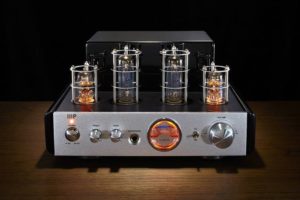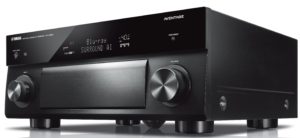Constructing a Hi-Fi Audio Setup
The world of high-end audio is, if nothing else, intimidating to newcomers. For those who desire the best-of-the-best, this passion can lead to endless searches for the best equipment and better audio. That said, there are many ways to approach Hi-Fi audio, and such setups are endlessly customizable. That said, knowing what to buy and where to start are often the biggest hurdles for those wishing to expand their audio capabilities. Because of this, I feel it is worth attempting to provide a brief guide to what one needs to begin.
What's Most Important?
There are numerous components and variables to consider when constructing a Hi-Fi system, but in reality there are only a few necessary components. The "key" parts of the setup are the receiver, speakers, and the audio source. These are absolutely necessary, and each has a significant impact upon the final sound quality that the setup will produce. The audio source is your primary device which generates the signal that is then sent to your receiver and, ultimately, speakers. Sources include televisions, vinyl or mp3 players, Blu-ray players, etc. Without a solid audio source, the rest of your system's output will suffer. Receivers do what their name implies- they receive multiple signals from your sources, then process and output them to speakers. These can be, and sometimes are, exchanged for amplifiers. For the purpose of this article, I will be working under the assumption that a full A/V receiver is desired. First, you will want to consider what your source is. Are you wanting to boost the quality of your home entertainment system? Do you just want better audio to come through your mp3 or vinyl player? If you are wanting a full home theater, you need to consider the television you are using along with the (assumed) Blu-ray player.Your Sources
As stated before, your sources are those devices from which a signal is transmitted to your receiver and then speakers. In the case of a home theatre, these will likely be a projector, television, Blu-ray player, or a combination of such. These are each vitally important components of any Hi-Fi home theater, and should be treated as such. Choosing sources is easily one of the most important decisions one can make during this entire process. For all of these, you will want to consider what types of surround-sound they support. I will go into more detail on this later, but for now know that they will likely support either 5-Channel, 7-Channel, or 9-Channel surround sound. As far as other audio technologies are concerned, some of the highest end, most sought-after features are DTS:X and Dolby Atmos support. These require specific A/V receivers and speaker setups, so it is worth keeping that in mind from this point onward. Your desired setup might require specific sources, receivers, and speakers in order to function correctly. Televisions also have certain options that tend to scale with cost- specifically, 4K/UHD video and HDR are premium options today. Size is also going to scale with cost, particularly when it comes to televisions which have the former features. Blu-ray players will generally need to support many of these same features as well, so if you plan to have a Blu-ray and television-based home theater you should consider that.A/V Receivers
From there, you will need to connect your television or monitor (and additional peripherals) to a receiver. Choosing a receiver can be tricky, but there are a few variables which are worth keeping in mind. Price is an obvious one, and receivers come in a wide variety of prices-ranges. Truly high-end ones can cost $1500 or more, while others are significantly cheaper. The primary differences will come down to the features available on each device, as price does tend to scale with quality when it comes to receivers. When it comes down to features, there are a few that I would consider. What type of surround sound do you want? This might also effect the speakers that you go on to purchase, along with their price. You are typically going to be looking at 5-channel, 7-channel, and 9-channel options. Five channel audio offers a central channel, left and right front channels, left and right surround channels, and a subwoofer channel for bass. Seven channel is the same, but splits the rear channel and surround into four separate channels. This provides a notably more detailed and 'wider' sound than 5.1- as a result, it tends to cost more but is more commonly sought. Lifewire has an excellent article discussing these two types of surround sound, discussing their significance in greater detail. 9-Channel surround sound is a newer technology and the most expensive of the bunch. ELITE A/V has an excellent article discussing this in more detail. They state:"A 9.1 surround sound system consists of nine speakers and one subwoofer. It uses two front-height channels. Therefore, with its 2 extra channels, 9.1 offers more audio depth and dimension. 5.1 and 7.1, on the other hand, only deliver a horizontal soundfield. This means audio is directed at the viewer from just one vertical plane."
In general, this creates a more 'cinematic' audio experience and a much wider range of sound. The downsides are that, of course, it is expensive, along with the fact that it requires a highly specific setup to use.

 Home theater systems have come a long way in recent years. What began as a TV with surround sound speakers and a basic audio/video receiver or equalizer has evolved into a highly versatile media system, capable of interacting with a variety of other devices and data. Just 15 years ago we used to boast about how real our surround sound seemed during an action movie. Today we can watch the movie without a disc by streaming in 4k Ultra HD over a high-speed wireless internet connection. We have Blu-ray Players with internet browsers and apps, TVs with voice control and multi-room audio controlled by centrally located audio/video receivers. We can use our smartphones to control the volume or change media from other parts of our homes and we can wirelessly send home videos to our Smart TVs for easy family viewing. We're living in an age of rapidly advancing technology and 220 volt audio/video receivers are just one of the many conveniences we're able to use for our multi-media enjoyment.
Home theater systems have come a long way in recent years. What began as a TV with surround sound speakers and a basic audio/video receiver or equalizer has evolved into a highly versatile media system, capable of interacting with a variety of other devices and data. Just 15 years ago we used to boast about how real our surround sound seemed during an action movie. Today we can watch the movie without a disc by streaming in 4k Ultra HD over a high-speed wireless internet connection. We have Blu-ray Players with internet browsers and apps, TVs with voice control and multi-room audio controlled by centrally located audio/video receivers. We can use our smartphones to control the volume or change media from other parts of our homes and we can wirelessly send home videos to our Smart TVs for easy family viewing. We're living in an age of rapidly advancing technology and 220 volt audio/video receivers are just one of the many conveniences we're able to use for our multi-media enjoyment.


